Instruction
1
If it is assumed that the number includes all N elements, and none is repeated, it is the problem of the number of permutations. The solution can be found by simple reasoning. First in the row can be any of N elements thus obtained N options. In the second place, moreover, which was already used for the first place. Consequently, each of the N already found options there are (N - 1) second place, and the total number of combinations is N*(N - 1).
The same reasoning can be repeated for the remaining elements of the series. For the last place there remains only one option — the last remaining item. For last two options, and so on.
Therefore, for a number of N distinct items the number of possible permutations is equal to the product of all the integers from 1 to N. This work is called factorial N and is denoted N! (read "n factorial").
The same reasoning can be repeated for the remaining elements of the series. For the last place there remains only one option — the last remaining item. For last two options, and so on.
Therefore, for a number of N distinct items the number of possible permutations is equal to the product of all the integers from 1 to N. This work is called factorial N and is denoted N! (read "n factorial").
2
In the previous case, the number of possible elements and number of seats number of match and the number is equal to N. But it is possible that in a number of smaller places than there are possible elements. In other words, the number of elements in the sample is equal to some number M, where M < N. In this case the problem of determining the number of possible combinations can have two different options.
First, you may need to count the total number of possible ways to rank M elements of N. Such methods are referred to as placements.
Second, the researcher may be interested in a number of ways to choose M elements from N. the order of the elements is not important, but any two choices must differ by at least one element. Such methods are called combinations.
First, you may need to count the total number of possible ways to rank M elements of N. Such methods are referred to as placements.
Second, the researcher may be interested in a number of ways to choose M elements from N. the order of the elements is not important, but any two choices must differ by at least one element. Such methods are called combinations.
3
To find the number of permutations of M elements from N, one can resort to the same way of reasoning as in the case of permutations. In the first place is still can stand N elements, the second (N - 1), and so on. But for last place in the number of possible variants is equal to one and (N - M + 1), since, when the placement is finished, there remain (N - M) unused elements.
Thus, the number of allocations of M items from N is equal to the product of all the integers from (N - M + 1) to N, or, equivalently, the private N!/(N - M)!.
Thus, the number of allocations of M items from N is equal to the product of all the integers from (N - M + 1) to N, or, equivalently, the private N!/(N - M)!.
4
It is obvious that the number of combinations of M elements of N will be less than the number of placements. For each possible combinations is M! possible placements that depend on the order of the elements of the combination. Therefore, in order to find this amount, you need to divide the number of allocations of M items from N is N!. In other words, the number of combinations of M items from N is N!/(M!*(N - M)!).
